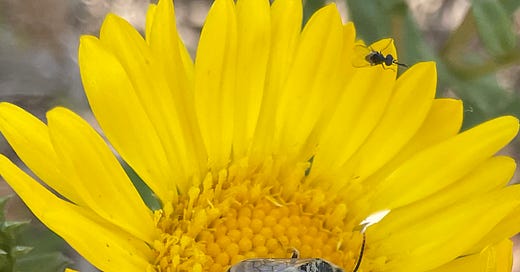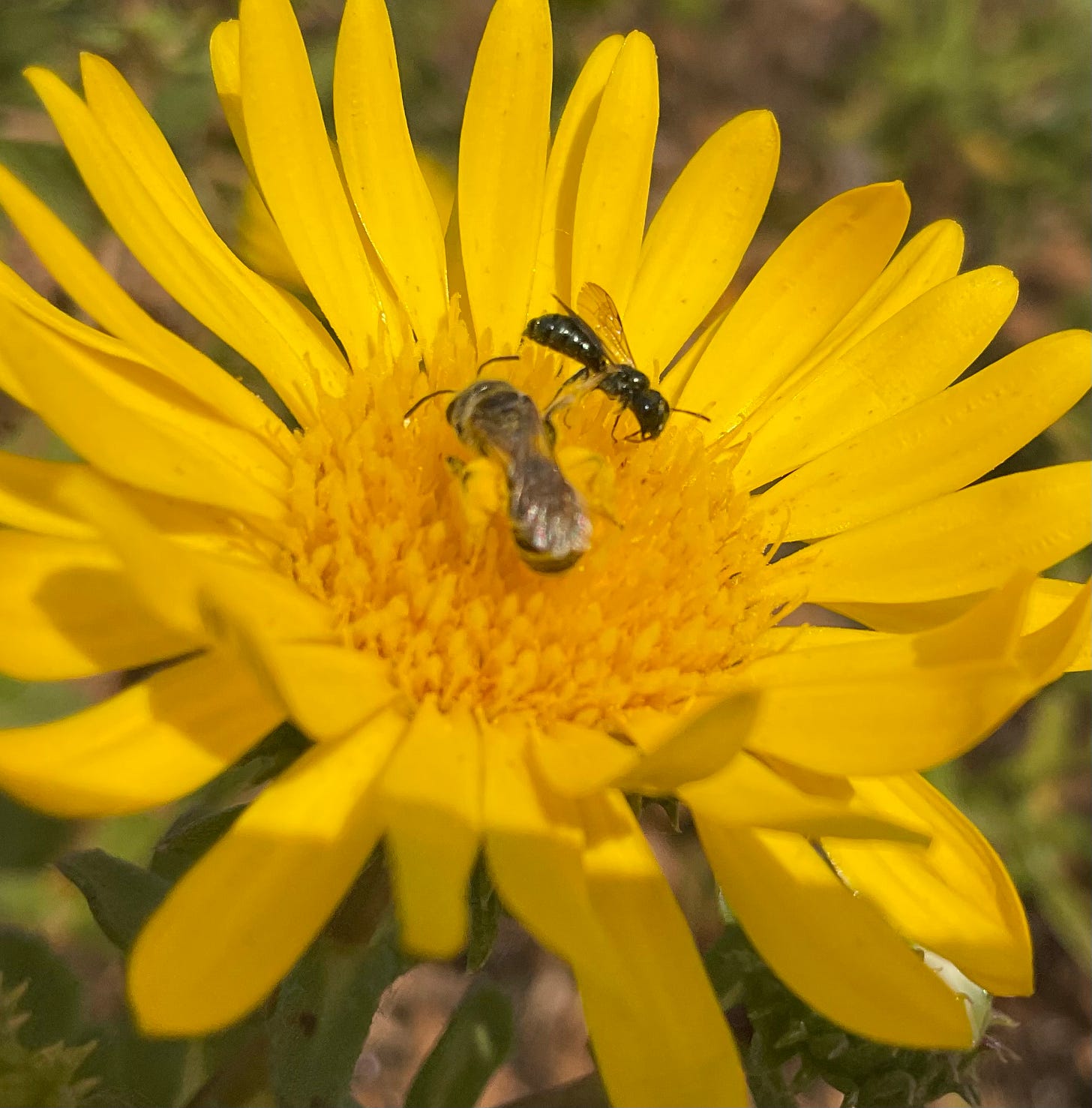Just yesterday, while tending to the landscaping at work, I noticed the distinctive metallic green of a sweat bee shining as he sought his lunch on the disk of a California sunflower. As quickly as I spied it, the bee flew off, too swift for me and my attempt to open the camera on my phone.
I like bees. I’m charmed by their bright colors and admire their industriousness. When I think of them, I tend to think of honeybees, with their queens and colonies, but there are lots of other species—carpenter bees, mason bees, bumblebees, sweat bees, and more—that are largely solitary species. Carpenter bees carve holes into wood for nesting. Mason bees nest in narrow gaps in stone or brickwork, and they often take over abandoned nests of carpenter bees. Others, such as bumblebees, nest in the ground.
I recently wrote about cities offering some sanctuary for migratory birds. Similarly, researchers are finding that cities also serve bees. A review of recently published research on bees found they are plentiful in grasslands, forests, and other natural lands, but cities harbor more bees than agricultural areas. The paper was published in the journal Ambio in May 2024.

The authors explain that big farms have row after row of a single crop, offering a single food source that may attract few bee species, but cities will contain a variety of plants, attracting a lot of different species. With trees and old buildings, cities offer diverse nesting sites for bees, particularly mason bees. (The authors did not mention pesticides, which I believe is an oversight on their part. Besides killing off pests, these poisons kill bees as well.)
They also found that nonnative bees, such as honeybees, are drawn to urban areas because of the greater number of exotic and cultivated plants. Additionally, they found that other social bees that live in colonies enjoy city life, although they couldn’t find an explanation for this phenomenon.
The more flowers in a city, the more bees. And the larger the green space in a city and the wider variety of flowers it has also translates into that city having more bees. It also helps if there is connectivity among a city’s green spaces and connectivity to the neighboring countryside.
As the planet warms due to climate change, cities are greening up, planting trees and other plants to keep cool. The authors of this current paper suggest that urban bee ecology should become part of this process to create more bee-friendly cities.
Going beyond floral measures, urban bee ecology may inform urban planning to design inherently bee-friendly cities. For cities to become bee inclusive, it is important to determine how the urban environment and its characteristics affect these pollinators. The authors stress that cities should increase the size of their green spaces, prioritize native flowering plants and plants that are known to be preferred by native bee species.
To promote bee-friendly landscaping, governments and conservation groups can capitalize on people’s love of bees. A study out of England found that gardeners, for the most part, like to support bees. Governments and conservation groups can help these gardeners by ensuring that plants and seeds are labeled as bee friendly and providing information on which plants different bee species prefer.
Urban beekeeping of honeybees, has gained popularity in the last 20 years. While seeking to avoid its hazards, municipalities have passed ordinances to promote the practice. In more recent years, organizations and individuals have tried to make cities friendlier to beekeeping as well. But those honeybees compete with native bees and drive them out of habitats, in the city or country. And some municipalities may have over-promoted beekeeping. A recent paper, published in January in Urban Ecosystems came to the conclusion that, despite regulation, some parts of Vienna, Austria, may have four times as many apiaries as the urban habitat can support.
More bee science news
France
Because of their isolation, with many of them protected as natural preserves, regional nature parks, and marine nature parks, the many islands off the coast of Brittany retain well-preserved natural and semi-natural habitats. In a survey of 25 Breton islands, scientists found 188 wild bee species. Some smaller islands had a single species or only two or three, while others harbored numerous species. The scientists recorded 113 wild bee species on the island of Groix, 82 species on Houat, 64 on Hoedic, and 57 on Ouessant.
The island bees included 12 near-threatened species and two listed as vulnerable in the European Red List of bees: the large carder bee and the hairy saddled Colletes.
A similar survey in the Mediterranean region of France recorded 246 species of bees.
Belgium
During a five-month period, a research team surveyed 32 sites in the recently established Semois Valley National Park. They recorded 120 bee species, 22 of which are listed as threatened in Belgium on the Red List. Four are critically endangered. They found that native grasslands support the greatest number of bee species and the highest number of threatened species.
Do you like bees? Have you seen any recently? Would you like for your city to be bee-friendly? Please share your experience by clicking the “Leave a comment” button below.







Great read! I’m just getting into native bees and love to see the variety, unique behaviors, and relationships with plants and other wildlife. It makes me stop and appreciate every flower and take a close look at the little details. Hopefully we can continue to make habitat for our native bees!